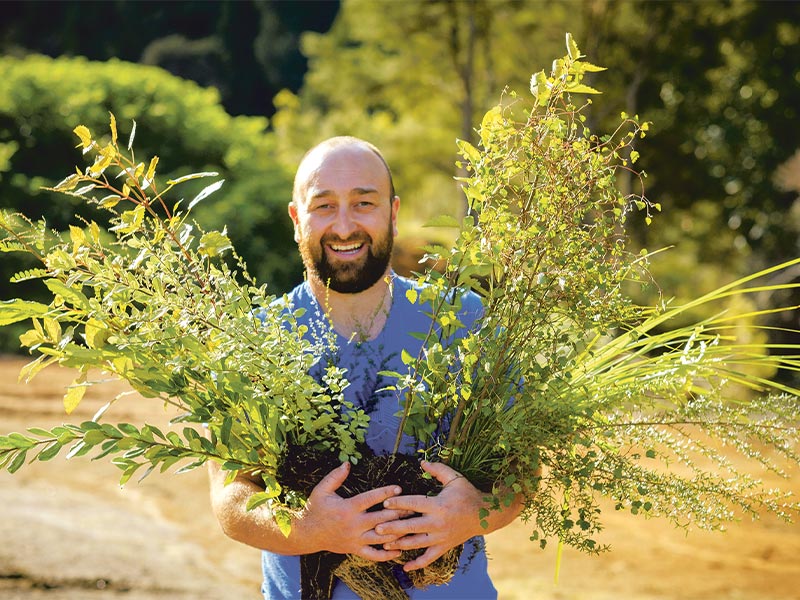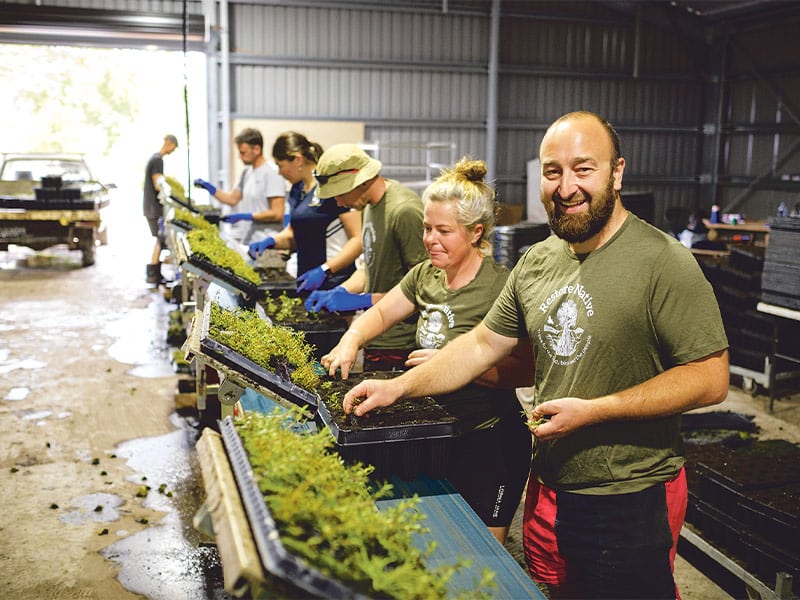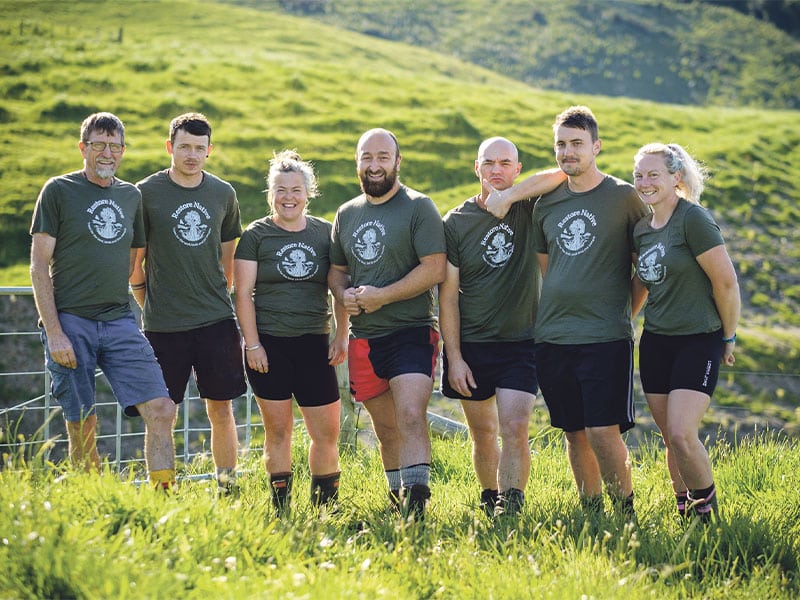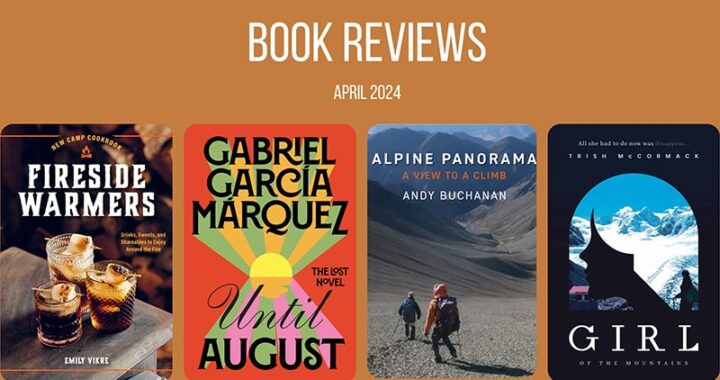Restore Native: growing a greener future
6 min read
Adam Thompson
Waikato farmer Adam Thompson can recall the moment he was sure he was on the right career path.
“I was given a Father’s Day card by my daughter, inside which she had described what I do for a living,” he says.
“I could imagine a time when my kids would have said, ‘my Dad talks on the phone and looks at spreadsheets’. But instead, my daughter had written: ‘my Dad grows trees to make the world a better place’.
“I love my kids like nothing else, and they are a big part of why I chose to follow my dream.”
That dream – to cost-effectively and sustainably restore marginal land to native bush on as many farms as possible by establishing his business, Restore Native – has its foundations in Adam’s childhood.
His family has green running through their blood: his grandparents and great-grandparents were market gardeners and viticulturists. Adam also grew up in the country, with his parents working as farmers and market gardeners throughout his childhood.
“I’ve wanted to be a farmer since I was five years old,” he says. “In my teens and early 20s, not so much, but it was still in the back of my mind.”
Despite spending 15 years working in finance, Adam kept his dream at the forefront of his mind.
“The goal was to buy my own farm, so to achieve that I pushed along my hobby of growing trees, which I had done since I was 21 years old,” he says. “I was growing a few thousand here and there. Along the way, I found out I needed heaps – and I realised that everyone else does, too!”
Five years ago, Adam took a leap and purchased a 175-hectare property, deciding it was time to make a commercial venture out of his love for growing trees.
The farm is classic rolling hill country farmed with traditional methods. In addition to the 30 acres of existing native bush, which provides Adam with a large seed bank for growing plants, there are approximately 50 hectares of wet and steep areas not suitable for farming that Adam is retiring and planting with natives; he has a goal of digging in 250,000 trees.

But perhaps the star of the property is Adam’s five-hectare native tree nursery, which grows an incredible one million native trees each year and is tracking to grow even more this year. Around 20 varieties of native plants are grown on the property.
The idea behind Restore Native was to create an avenue for farmers to access native trees and retire marginal land, without having it cost the earth.
“For a lot of people, we start with their problem – such as having a wet or steep area – and I go out to their property and have a yarn, map the area with a drone, plan the species they need and how far apart to plant them, look at site preparation, supply plants, and then undertake planting and post plant care,” Adam says.
“On the other hand, some people say, ‘I want 1000 pittosporums’, and we just supply the plants.”
Adam says beliefs around native planting can be fraught with misconceptions.
“There is the misconception that native trees are expensive,” he says. “People say, no, they’re way too expensive, but they have no idea how much they actually cost. It’s like saying a Mercedes is expensive, but when you compare prices, it might cost the same as a Mazda.
“Our ambition is to provide good value trees under a cost-effective solution. I started thinking, if the Government is not fully funding some trees, am I able to do it?”
Another misconception is about carbon sequestering.
“With the current structure around carbon, people think they can just plant trees and sequester the carbon, which favours pine planting heavily,” Adam says.
“If they have land to retire, they think they should plant pines and at least make some money off it. We need to shift the dial on that and get in a position where people feel they get an incentive for planting native trees.”

And that incentive should not only be financial, Adam says.
“There are tonnes of benefits to planting natives: water and air quality and biodiversity are just some of them,” he says. “We need to remember to look at other incentives that aren’t money-related – how about the pride that accompanies having healthy land?”
Adam says there is no one-size-fits-all approach to a native planting plan; no particular species of plant is ‘better’ than another.
“It’s like asking, what’s the best seafood? There’s fish and shellfish and other types of seafood,” he says.
“Native bush is a collection of plants, and all plants have a place. Which plants suit a farm best is unique to the farm.”
Although plant selection is very individual to a particular property, Adam says manuka and kanuka form the cornerstone of a lot of planting projects.
“They are super dependable, hardy, grow well from seed,” he says. “But they don’t attract birds. So, totara and rewarewa form a good basis for emergent trees that wind up being the forest canopy.”
Adam, who has no formal education in horticulture, says someone once told him, “You’ll pay for your education, one way or another”.
“For me, it was a case of no formal training in horticulture, but a lot of trial and error,” he says. “My own farm has acted as a trial plot – we have some successes, and we bring them to market, and we have some not-so-successful, so we have to go back to the drawing board.
Adam says an important part of restoring native forests is to ensure they are given the best chance of succeeding – and that means removing predators.
“It’s all about working with the cycle of native bush,” he says. “Predators interrupt that cycle. You can plant a tree and establish a forest, but you need birds to eat fruit and spread seeds. Possums browse trees, which can kill them, and rats eat birds. Rats also eat the fruit, so the seeds don’t germinate. Removal of predators after about 10 years is crucial; predator control is more about protecting the forest we have established.”

Adam also established Predator Free Cambridge, of which he is a trustee.
“It’s a pretty cool project,” he says.
Last year, Adam was recognised for his work when he and his team won a 2023 Primary Industry NZ – Kaitiakitanga/Guardianship & Conservation Award.
“It’s very humbling,” he says. “You don’t seek out to win awards, but it is particularly cool for our team. I’m happy to be out knee-deep in mud planting trees because I have a long-term belief in what we are doing, but for some of our younger team, it’s not as easy to picture.
“For the team to achieve this is a wonderful thing, and really rewarding. Having a great team behind me means I can achieve far more than if I went it alone.”
Adam says there is a generational shift of farmers wanting to protect the land more, but we must have patience.
“The forests in New Zealand weren’t cleared in a day, so we won’t be able to restore it in a day, either,” he says.
Adam says he is also enjoying setting an example for his children, reminding them that doing a practical, physical job is a good thing.
“Get outside and touch the dirt!” he laughs. “I think that’s where a lot of the undervalue of farmers comes from. People used to say, ‘if you’re no good at school, you can be a farmer’; we need to shift the dial.
“I think a lot of people lose purpose because they are not involved in anything meaningful.”
Words by Anne Boswell, images supplied



